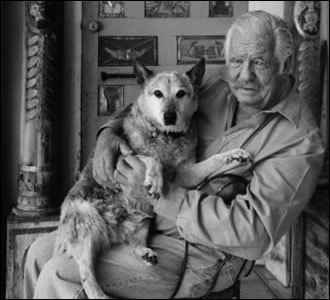Santa Fe Living Treasures – Elder Stories
<<Back to Treasures Index
Ford RuthlingART & SOULHonored October, 2003 |
Ford RuthlingWhere to begin with Ford Ruthling? Probably at birth, for he is a New Mexico native as well as a Santa Fe original. His mother, Helene Maurer Ruthling, came to Santa Fe in 1916, as governess to the grandchildren of Mabel Dodge Luhan, the legendary arts patroness in Taos. He grew up on a farm in Tesuque, when it was just a rural village. Now Ford Ruthling is a nationally and internationally known artist, a fervent preserver of traditional art (even as he takes that art to new evolutions), and a local legend in his own time, in his own right—as much for his world-class bonhomie as his art. Somehow he has held onto a three-acre enclave in the South Capitol neighborhood, just blocks from the Santa Fe Plaza, and has made his place a magical, other-worldly little world, long to be remembered by many of the thousands of people who have partied there. Along the way, Ford Ruthling has seen his art shown and collected nationwide—in the Smithsonian Institution in Washington, the Dallas Museum of Fine Art, certainly the Museum of New Mexico; in galleries in Denver, Los Angeles, Seattle, San Francisco, Aspen, Tulsa, Dallas, time and again in Santa Fe; in private collections of well-known people such as department-store magnate Stanley Marcus, television journalist Morley Safer, movie star Vincent Price, oilman Robert O. Anderson, and countless others. In 1977 four of his paintings of New Mexico Pueblo Indian pottery became a series of U.S. Postal Service first-class stamps. Now in Congress is a move to reissue the stamps. Ruthling traces his origins, his inspiration, and his success to New Mexico—back then. He saw himself as a farm kid, finding whiskey bottles outside the two-room school in Tesuque, scavenging for food in grocery trash bins during the Depression, taking his family's friendship with acclaimed artist John Sloan—and local Indians—for granted, as just a part of life. When Ford Ruthling made his own life, this was the life he chose. He has amassed an unsurpassed collection of relicarios, santos and nichos, examples of the Spanish and Mexican art that preceded the modern age. He was inspired by tin-can stampings made here in times of poverty, and has elevated such art to new forms. His work has been called "magic-realism," "veneration paintings," and, by The New York Times, "Santa Fe's soul stamped in tin." His amazing home reflects all of these aspects. Yet "humor is always a part of it," he says. A friend recalls "a plant of questionable legality" growing in his yard—and the painting of it and a bunny he later sent to her. Story by Richard McCord |
